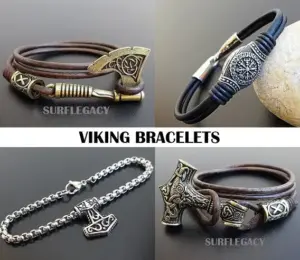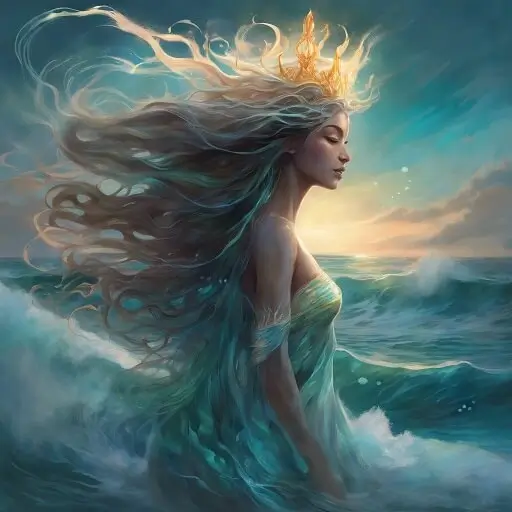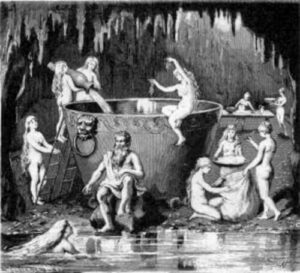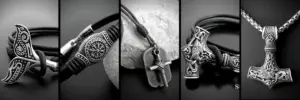In the captivating world of Norse mythology, among the pantheon of gods and goddesses, Rán stands as the embodiment of the unpredictable and often treacherous seas that the ancient Norse people revered and sought to understand.
As the goddess of the sea, Rán holds sway over storms, sailors, drowned souls, and the mysteries of the deep. While less known than prominent deities like Odin or Thor, her influential role intricately weaves throughout the fabric of Norse myths and reveals insightful aspects of how the Vikings viewed the ocean’s dual nature
Who is Rán in Norse Mythology?
In Norse mythology, Rán (Old Norse for ‘robber’ or ‘theft’), often anglicized as Ran and pronounced “RAN”, is a goddess personifying the sea. She is often depicted as the consort of the jötunn (giant) Ægir, who also personifies aspects of the ocean.
Her name reflects the Vikings’ conception of the sea as a treacherous place that ‘robs’ sailors of their lives. It captures the unpredictable and dangerous character they attributed to the ocean, despite relying on it for food, trade, and exploration.
As the goddess of the sea, she holds power over storms, waves, and the fate of sailors. She is frequently associated with a net that she uses to capture souls lost at sea and draw them to her watery realm at the ocean floor.
Ran’s influence in Norse mythology highlights the complex, often conflicting relationship the ancient Norse people had with the perilous yet bountiful sea.
| Category | Description |
|---|---|
| Name meaning | Old Norse for “robber” or “theft” |
| Pronunciation | RAN |
| Parents | Unknown |
| Partners | Ægir (sea jötunn) |
| Siblings | None known |
| Offspring | Nine daughters representing waves |
| Tribe | Aesir or Vanir goddess |
| Old Norse Name | Rán |
| Other Names | None |
| Domain | Goddess of the sea, storms |
| Associated Artifact | Her net |
| Symbols | Fishing net used to catch drowning sailors |
| Powers | Control over oceans, storms, fate of sailors |
| Relevance | Embodies the dangerous nature of the Viking seascape |
| Textual appearances | Poetic Edda, Prose Edda, Völsunga Saga |
| Worship | Vikings offered sacrifices for safe passage at sea |
| Modern culture | Inspiration for Norse myth-themed media |
Ran’s Family Relationships with Ægir and the Nine Daughters
In Norse myths, Ran’s primary family relationship is with her husband, Ægir, and their nine daughters who embody different aspects of ocean waves.
The Marriage to the Jötunn Ægir
The jötunn Ægir, whose name means ‘sea’ or ‘ocean’ in Old Norse, is Ran’s husband in Norse mythology. Together, they symbolize the duality of the sea—its life-giving bounty as well as its destructive danger.
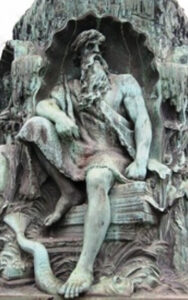
Ægir
Ægir holds lavish parties in his underwater hall for the gods, brewing fine ales and meads, symbolizing the ocean’s abundance. In contrast, Rán with her net embodies the sea’s lethal aspects that claim unwary sailors, reflecting the Vikings’ respect for the ocean’s perilous nature.
Ran and Ægir’s marriage connects them in overseeing all facets of the sea, a reminder of sailors’ dependence on the changeable tide’s whims. Their unionavy underscores the rich maritime foundation of Norse culture.
The Nine Daughters as Personifications of Waves
Ran and Ægir also have nine daughters, often referred to as the billow maidens or wave maidens. Each embodies a different type of ocean wave, representing the multifaceted nature of the sea from breezy ripples to towering swells.
The daughters’ names poetically evoke vivid images of waves:
| Name | Meaning |
|---|---|
| Himinglæva | Sky clearer or transparent wave |
| Dúfa | The pitching one |
| Blóðughadda | Bloody hair |
| Hefring | Riser |
| Uðr | Frothing wave |
| Hrönn | Welling wave |
| Bylgja | Billow |
| Dröfn | Foam fleck |
| Kólga | Cool wave |
These daughters underscore the changeable moods of the ocean, calm and nurturing at times, wild and destructive at others, their collective presence as extensions of Ran and Ægir demonstrates the rulership the goddess and the jötunn held over the untamable sea in the Norse imagination.
Ægir, Rán and their nine daughters preparing a huge vat of ale.
Ran’s Role and Significance as a Sea Goddess
As the goddess personifying the ocean in Norse mythology, she plays a pivotal role tied to the domain she rules – the sea in its myriad manifestations.
Ran’s Rule Over the Unpredictable Seas
The Goddess holds power over the changeable, often destructive seas that the Vikings cautiously traversed. She has control over raging storms and tempestuous waves, able to whip winds and swells into a frenzy leading ships into peril. This chaotic might she wields reflects ages-old Norse respect for the sea’s volatility.
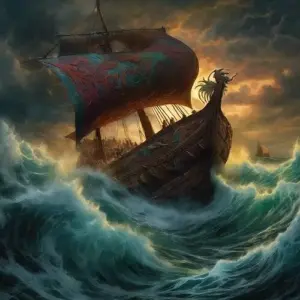
She also governs the fates of drowned sailors, her net allows her to snare sea-farers, dragging them into the depths of her watery halls to feast with Ægir. In this manner, she embodies the lurking danger the unreliable ocean posed, where storms or serpents could surface without warning and doom ships despite skillful seamanship.
As such she stands as a prominent reminder of the sea’s caprice which sailors relied upon yet feared. Her mystical workings as a deity captured in mythic form the reality of the precarious balance required for Vikings braving the seas.
Rán’s Authority Over Aspects of Freshwater Too
In addition to her marine rulership, some sources indicate Rán held dominion over lakes and rivers too. This tied her powers to all types of waters Vikings traversed during trade or exploration.
Her menacing net could spread across any waterway, meaning maritime travelers would need to offer respect wherever they journeyed over the waves to avoid her wrath. With Rán over fresh waters too, no aquatically navigated route proved fully safe without granting the goddess proper homage.
Thus Rán’s authority encompassed all forms of aquatic travel familiar to the Vikings. This consolidated her importance when voyaging through the Viking realm across its many lakes and sea-roads.
Symbols and Artistic Depictions of Rán in Norse Mythology
Like all Norse deities, Rán possesses symbols, objects, and imagery associated with her mythic persona and the domain she rules. Her icons provide deeper insight into her character and sphere of influence.
Significance of Rán’s Infamous Net in Norse Lore
The most iconic object linked to Rán is her net. This specially designed net allows her to capture sailors and ensnare entire ships, dragging them down into her domain. Its strands bind victims mercilessly, preventing any chance of escape once cast over its targets on the waves.
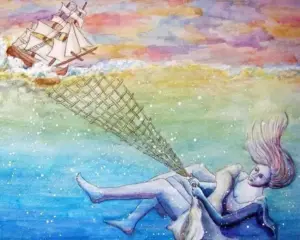
As such, Rán’s net serves as an instrument of death, symbolizing through its intricate weave the inescapable fate that awaits those she snares within it.
For Vikings, the net evoked the peril of voyage, where one misstep could doom sailors to a watery grave and endless feasting in Rán’s hall. It signified the fine line between smooth sailing and catastrophe on the capricious sea.
The mention of Rán’s net across Norse mythic texts and poetry firmly established its fame and her authority over binding mortal lives. It visually distills her powers over storms and drowned souls, clarifying why sailors both respected and feared this mysterious goddess.
Artistic Renderings of Rán Reflect Dual Aspects
Based on her mythical role, artistic depictions of Rán showcase a stunning, formidable goddess of the depths. She is frequently portrayed as hauntingly beautiful with almost mermaid-like features, conveying the ocean’s aesthetic allure for sailors.
Yet aspects of her appearance also hint at deadliness, such as sharp claws or teeth. She may be shown with stormy sea imagery like crashing waves, representing her more destructive side aligned with ocean tempests and snaring victims with her net. This melding of striking beauty with lethal danger mirrors the dual sides of the oft-treacherous Viking seascape itself.
When rendered alongside Ægir, Rán stands as a contrast to his hearty feasting and joviality. Her somber, mystical visage serves as a visual reminder that at sea, the life-bringing waves can instantly turn life-taking for those caught unprepared. As such artistic impressions of Rán encapsulate in symbolic fashion core Norse perceptions of the magnificent yet unpredictable ocean.
Appearances and References in Norse Mythology Texts
While less extensively featured than some gods like Odin and Thor, Rán plays key roles across seminal Norse mythology texts. Her appearances provide insight into her significance within the Viking pantheon and their maritime society.
Poetic Edda
Rán appears in three main poems within the Poetic Edda, demonstrating her relevance in the Norse mythic canon.
In “Helgakviða Hundingsbana I,” Rán creates a perilous tide that the valkyrie Sigrún helps a boat escape from, emphasizing Rán’s powers over storms and threats to sailors.
In “Helgakviða Hjörvarðssonar,” she receives mention as a deadly peril for ocean travellers that the hero Atli narrowly avoids, highlighting her menace.
Finally in “Reginsmál,” the trickster god Loki actually borrows Rán’s net, underlining her ownership of this symbolic article tied deeply to fate and ocean deaths.
Through these Poetic Edda appearances, Rán’s significance as a deity governing seafaring troubles and dooming sailors vividly comes to the fore.
Prose Edda
Ran plays an even more prominent role in Snorri Sturluson’s seminal Prose Edda from the 13th century.
She is showcased in the Skáldskaparmál section where she assists sailors and allows Loki to borrow her net, emphasizing her authority over sea-farers’ fates through this symbolic article.
In Háttatal, Rán helps establish kennings – poetic Norse metaphors – relating to the sea. She also receives listing as a goddess in the Nafnaþulur section, solidifying her standing in the Norse pantheon.
Beyond her direct inclusion, Rán also links to other vital myth elements in the Prose Edda. Her husband Ægir represents a god whom even Odin visits to gain magical wisdom tied to brewing mead and ale. And their daughters appear during great feasts for the gods, resonating with major mythic motifs.
With this level of prominence, she clearly holds major stature in the Prose Edda’s presentation of Norse legends. Her role interweaves through many seminal accounts and connections.
Völsunga Saga
In the renowned Völsunga Saga, a pivotal Norse legendary saga, Rán plays a significant role that mirrors her domain.
When Loki needs a magical net to capture the dwarf Andvari, who transformed into a pike, he borrows Rán’s powerful net to ensnare his aquatic prey successfully.
This highlights Rán’s ownership of a mystical and potent net, allowing Loki temporary use for his objectives. It underscores her authority over artifacts intertwined with destiny and the very essence of the ocean.
Sonatorrek and Friðþjófs saga
Beyond the major mythology texts, she also surfaces in seminal early Norse literature such as the 10th century poem Sonatorrek and fabled Friðþjófs saga.
Sonatorrek features a tragic theme of loss relating to the sea, with Rán’s lethal activities resulting in the speaker’s son drowning. This positions her as a deity associated deeply with ocean deaths and the grief they cause.
In Friðþjófs saga, she receives more indirect reference as a metaphor for the sea itself that the protagonist believes will claim his life amidst a storm. However, this still poetically connects her to the ocean’s peril and her ability to conjure a sailor’s fate.
Across these works and others, Rán maintains a poetic symbol-status infused with oceanic potency and darkness – a testament to her mythic relevance.
Ancient Viking Perspectives on Appeasing the Goddess
As a goddess associated with storms and maritime mishaps, ancient Vikings would attempt to honor and appease her before risking necessary sea journeys.
Viking Efforts to Placate Rán’s Potential Wrath
Braving voyage across the surround North and Norwegian Seas or inner waterways stood as a necessary danger for Vikings. Since Rán held influence over the tide and troubles to befall sailors, Vikings would offer appeasements in hopes of her benevolence.
Historians note possible Viking Age offerings found at sites like Tissø indicating gifts and respect paid to the tempestuous goddess. And mythic accounts like Friðþjófs saga reference needing to please Rán to avoid her destructive whims.
Overall Vikings took care to acknowledge Rán’s authority by providing suitable sacrifice, flattery, invocation, or tribute to minimize her offense and curry her blessing. This caution around the goddess aligned with practical efforts taken by actual sailors facing storms.
Carrying Gold as Protection in Myths and Reality
One captivating method of safeguarding against Rán’s potential wrath involved carrying gold treasures aboard ships. In stories like the Friðþjófs saga, laden vessels with gold and jewels symbolically honored Rán and her realm, seeking safe passage.
This mythical practice found parallels in reality. Archaeologists have uncovered ships with gold intended as ceremonial offerings. Historical records note sailors occasionally casting golden items into the sea to appease adverse weather, mirroring these mythic traditions.
Vikings thus employed practical reverence and symbolic gestures, intertwining myth and reality to appease Rán and seek her benevolence on their sea journeys.
Rán’s Relevance in Modern Culture and Norse Paganism
While originating centuries ago, Rán and her captivating mythic history continue engaging modern audiences. She influences wider pop culture while holding appeal among followers of renewed Norse pagan paths like Asatru.
Rán’s Appeal in Contemporary Books, Shows and Games
As interest around Norse mythology and Vikings heightens, she gets incorporated into various facets of popular media today. Fantasy authors like Neil Gaiman feature her story or inspiration in novels, while Marvel comics weave her iconography into superhero tales.
She also arises in acclaimed video games such as 2018’s God of War drawing on Norse lore as well as the Smite series. And speculation abounds she may appear in the hit show Vikings: Valhalla for its second season.
In these ways and more, Ran enjoys indirect modern visibility through ongoing Norse themes in mainstream books, shows, and streaming entertainment. Audiences continue discovering her compelling backstory and ties to the darker side of the memorable Viking seascape.
Rán in Contemporary Pagan Movements
For devoted followers of Old Norse beliefs like Asatru and Vanatru, Ran remains a revered oceanic goddess, deserving respect. Rituals across these groups often revolve around ensuring safe passage through her seas.
Within Norse-inspired practices, many pagans honor Ran, acknowledging her ancient significance in controlling storms and waterways that impact modern travels.
Just as Vikings sought her favor, modern pagan communities offer gifts at water sites before sea or lake journeys, seeking her protection through active and meditative spiritual acts.
Across time, this sea deity maintains her symbolic and religious significance for those embracing Norse mythology, bridging ancient traditions with contemporary belief systems.
Faqs
Why is Rán associated more with the dangerous aspects of the sea?
Unlike her husband Ægir who oversees the bounty and hospitality of the ocean, Rán specifically embodies the treacherous and unpredictable character of the sea in Norse myths. This dangerous side was very real for Viking sailors, who relied on safe voyages for their livelihoods.
Did Vikings pray to Rán during sea storms?
Yes, Vikings would often pray to Rán and make offerings during intense sea storms to appease her wrath. By acknowledging her power over the winds and waves, they hoped to avoid shipwrecks or drowning.
Do we know what offerings Vikings made to Rán?
While details are scarce, historians believe Vikings occasionally sacrificed items like weapons, gold, and jewels either into bodies of water or at sites like Tissø in Denmark to honor and appease the goddess before sea journeys.
Why is Rán’s net so symbolic in Norse mythology?
Her net represents Rán’s ability to ensnare sailors and drag them down to her watery realm, drowning them to join the feasts of her underwater halls. Beyond actual drowning deaths, it symbolized the fine line between smooth sailing and catastrophe at sea.
Did Rán have any known temples or dedicated sites of worship?
Unfortunately, there are no records of dedicated temples or worship sites to Rán herself in surviving sources about ancient Norse religion. As a goddess tied closely to aspects of nature, she likely received more informal yet cautious propitiation from seafaring Vikings.
Conclusion
Ran stands as a central figure in Norse mythology, beautifully embodying the dichotomy of the ocean’s nurturing and destructive essence within the Viking mindset. As the goddess personifying the sea—its mysteries, wonders, and risks—her stories deeply influenced Norse culture.
Her portrayal as a relentless hunter, pulling sailors to their demise, emphasized why Vikings approached the unpredictable tides, crucial for exploration and livelihood, with caution. Rán’s infamous net, symbolizing fate, explains why wise sailors honored her before voyages into her Cold Sea domains. Her association with Ægir emphasized the importance of respecting the sea’s dual nature—capable of providing bounty or sudden harm.
Even now, Rán’s mythical identity serves as a metaphor for humans grappling with forces greater than individuals or clans. Vikings wove this reality into tales of gods like Njord, the storm-wielder, hospitable brewer Ægir, and fate-sealing Rán. Each embodied vital aspects of the sea, a reminder to voyagers of the ocean’s unpredictable nature.
In her, this precarious balance finds representation—a looming terror of typhoons or serpents clashing with the soothing rhythm of waves guiding voyages to new shores. Just as sailors can’t master the seas, no deity fully controls Rán except by her consent. She sails through human imagination wherever depths beckon and storms brew. Those venturing into Rán’s realm should offer homage to avoid joining the doomed crews in her endless underwater feast.
See also:
Norse Sea Goddess: Tales of the Oceanic Deity in Viking Culture
Shop Viking Jewelry
Are passionate about Vikings or Norse Mythology?
Finding the ideal piece of Viking Jewelry can be challenging and time-consuming, especially if you lack inspiration or don’t know where to look.
Surflegacy, has you covered. We have a wide range of Handmade Jewelry in various styles, shapes, colors, and materials, to accentuate your Viking spirit and look. Do not hesitate to visit our selection HERE